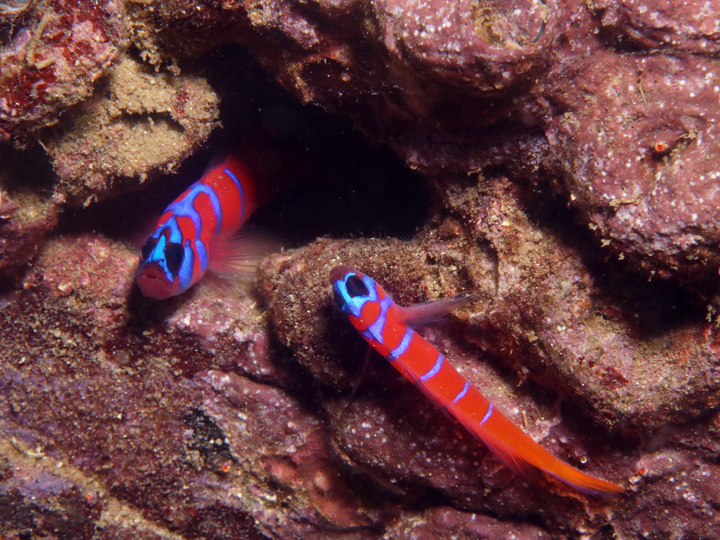The Blue‑Banded Goby: The Ocean’s Tiny Firecracker by Eco Dive Center in Los Angeles
Posted by Ronald Beltramo on on 3rd Apr 2025
If you’ve ever dipped below the surface in Southern California, chances are you’ve seen a flash of neon orange and blue darting across the rocks. That’s the blue‑banded goby (Lythrypnus dalli), one of the most dazzling—and fascinating—fish in our kelp forests and rocky reefs. Despite their tiny size, these gobies have big personalities, surprising biology, and a story that makes them one of the most beloved sightings for divers.
A Name with History
Their common name comes from the vivid blue racing stripes that pop against their bright orange bodies. But their scientific name tells another story: Lythrypnus comes from Greek roots meaning “concealed sleeping,” a nod to how they tuck themselves into crevices at night. The species name dalli honors 19th‑century American naturalist William Healey Dall.
Tiny but Bold
At just two inches long, the blue‑banded goby is proof that size doesn’t equal shyness. Unlike many gobies that bury into sand, Lythrypnus dalli hovers in the open, perches on rocks, and even confronts larger fish that wander too close. Divers often spot them inspecting, posturing, and zipping in and out of cracks in the reef.
Biology & Behavior Highlights
-
Eye‑catching Stripes: Their blue bands reflect polarized light, making them appear to glow underwater.
-
Territorial Spirits: Blue‑banded gobies defend their turf with gusto, opening their mouths and lunging at intruders in tiny fish face‑offs.
-
Sex‑Change Superpower: Living in harems (one male, several females), they can switch sex when needed. If the dominant male disappears, the largest female transforms into a new male to keep the group stable.
-
Skin Breathing: In addition to gills, they can absorb oxygen through their skin, allowing them to thrive in low‑oxygen crevices.
-
Symbiotic Roommates: Often found near red rock shrimp, the gobies benefit from cleaning while helping to keep watch for predators.
-
Toxic Armor: Their skin produces mild toxins, making them an unappetizing snack for larger fish. Some juveniles of other species mimic their coloration to “borrow” that protection.
Habitat & Range
Blue‑banded gobies are reef lovers. They prefer rocky substrates, kelp forests, and artificial reefs from shallow waters down to about 75 meters. Their range stretches from Monterey Bay in California all the way to northern Peru, including the Gulf of California. Here in Southern California, they’re most common in places like:
-
Santa Cruz Island – among the best goby habitats in the Channel Islands.
-
Anacapa & Catalina Islands – rocky walls and kelp forests.
-
Palos Verdes & Malibu – shallow rocky reefs where they perch on ledges.
Diet & Role in the Reef
Blue‑banded gobies are micro‑predators, feeding on tiny crustaceans, worms, and benthic invertebrates. In turn, their presence supports the reef’s food web and adds to the biodiversity that makes Southern California diving so vibrant.
Conservation Status
The IUCN lists the species as Least Concern, and they are abundant across much of their range. Still, like all reef fish, they depend on healthy ecosystems. Habitat loss, pollution, and reef degradation could affect local populations, making responsible diving and marine protection key to their future.
See Them for Yourself
Ready to spot these underwater “firecrackers”? Our dive boats regularly visit the Northern Channel Islands, where blue‑banded gobies thrive. Trips departing from Ventura Harbor head out to sites around Santa Cruz Island—some of the best goby hotspots in California. Look closely at rocky ledges and crevices, and you’ll almost certainly catch sight of their neon stripes.
Small Fish, Big Wonder
From their brilliant colors and fearless personalities to their gender‑switching abilities and clever survival tricks, the blue‑banded goby proves that even the smallest creatures can make the biggest impression. Next time you’re underwater in Southern California, slow down and take a closer look—you might just find one of these tiny reef dynamos staring back at you.


